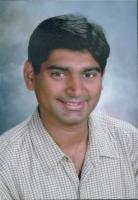Nathan Swami
Associate Professor and Graduate Program Director

Contact
Thornton Hall - C218
351 McCormick Road
PO Box 400743
Charlottesville, VA 22904-1000
Phone: (434)924-1390
FAX: (434) 924-8818
Email: nathanswami@virginia.edu
Webpage: http://people.virginia.edu/~ns5h/
Summary:
Nano-electromagnetics (NEMS) – Signaling at the nano/bio interface: The measurement, analysis and propagation of electrical, magnetic and optical signals with nanoscale spatial resolution is of interest within biomolecular sensing, morphogenesis, tissue regeneration, ion-channel signaling and the directed hierarchical assembly of materials. Our research group focuses on engineering nano-device interfaces to biosystems to harness electrical, magnetic, and optical signal transduction methodologies. Nanostructured devices, due to their enormous surface to volume ratio enable enhanced kinetics, sensitivity and heat transfer, as well as phenomena arising from sub-wavelength structures and the overlap of neighboring electrical double layers. We focus on electrokinetic enrichment, patterning and separation of biosystems for applications within early diagnosis of diseases; guidance of cells for tissue regeneration, and nano-assembly of materials.
Background:
Nathan Swami received his Ph.D. in Materials Science, at the University of Southern California in Los Angeles in 1998. His research was centered on developing device paradigms based on carbon nanomaterials. Following this, Nathan Swami was a Senior Scientist at a start-up company out of Caltech called Clinical Micro Sensors, Inc., working on developing microelectronic interfaces to molecular biology for eventual application as DNA sensors and lab-on-chip devices. Upon acquisition of the start-up by Motorola Inc. in 2000, he worked on the technical staff at Motorola Labs. After a stint as the Director of the statewide nanotechnology initiative, where he coordinated activities between numerous nanotechnology research centers within the state, he joined the faculty at the UVA Electrical & Computer Engineering Department in 2004. At UVA he teaches courses in semiconductor devices, directs the Electrical Engineering graduate program, and conducts research in the area of nano-bio devices.
Research
Our research is broadly organized within the following areas:
(1) Microfluidic devices for selective pre-concentration and separation of biological cells using electrokinetic and magnetic manipulation.
(2) Nanofluidic devices for dielectrophoretic enrichment of biomarkers for high-sensitivity detection of cancer biomarkers, mRNA from infectious agents, and viruses
(3) Electrical and optical signal transduction on micro- and nanofluidic devices: Integrating sensing with localized manipulation
(4) Electrical and magnetic methods for the alignment, patterning and hierarchical assembly of nanostructures
Most Recent Publications:
Recent Publications (Full list at: http://people.virginia.edu/~ns5h/ )
“Nanofiber size-dependent sensitivity of fibroblast directionality to the methodology for scaffold alignment”, V. Chaurey, F. Block, R. Su, P. Chiang, E.A. Botchwey, C.F. Chou, N. Swami*, Acta Biomaterialia (2012): http://dx.doi.org/10.1016/j.actbio.2012.06.041. Journal Impact Factor = 4.865
“Nano-constriction device for rapid protein pre-concentration in physiological media by electrokinetic force balance”, K.T. Liao, M. Tsegaye, V. Chaurey, C.F. Chou, N. Swami*. Electrophoresis (2012), 33, 1958-1966. Journal Impact Factor =3.3
“Interplay of electrical forces for alignment of sub-100 nm electrospun nanofibers at insulator gap collectors”, V. Chaurey, P. Chiang, C. Polanco, R. Su, C.F. Chou, N. Swami*. Langmuir (2010), 26 (24), pp 19022–19026. DOI: 10.1021/la102209q. Journal Impact Factor = 4.1
“Enhancing DNA hybridization kinetics through constriction-based dielectrophoresis”, N. Swami*, C.F. Chou, V. Ramamurthy, V. Chaurey, Lab on a chip (2009) 9, 3212-3220. Journal Impact Factor = 6.35
“Dielectric Properties of Biological Molecules in the Terahertz Gap”, Parthasarathy, R.; Globus, T*; Khromova, T; Swami, N.; Woolard, D. Applied Physics Letters (2005), 87, 113901-113903. Journal Impact Factor = 3.72